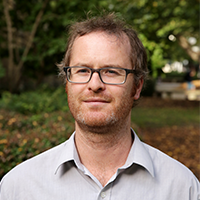The Deindustrial 2020 washing system. Click image to enlarge.
Introducing my post-electric washing machine, which I call the Deindustrial 2020. It’s of the future, not the past – although it does look rather like the old-style, Medieval 1450. It was made for only $2.
As you should be able to see from the picture, the Deindustrial 2020 is made up of two high-tech elements, a black plastic tub (which I salvaged from the side of the road), and an old crutch (which I purchased for $2). With these two pieces of technology I was able to construct a post-electric washing machine, which functions perfectly and doesn’t use any fossil fuels in operation. You could probably find appropriate materials for your own version around the house or in the shed.
Here’s how it works. I fill the tub half full with water and mix in half a cup of homemade washing detergent. I then put in a load of washing and let it soak for 5 mins while I sit in the garden and have a cup of tea with breakfast. I then lightly agitate the washing for a few minutes with the upside-down crutch, while singing Gangnam Style to myself and sometimes breaking into the dance. The crutch is ergonomically friendly as it allows me to stand up while I work and dance, and the padded under-arm part of the crutch is gentle on the clothes. I then tip the water out and refill the tub to rinse the clothes, agitating for another minute or two. The rinse water (depending on the detergent) could potentially be used on the fruit trees.
With the clothes now clean and rinsed, I remove them from the tub and squeeze them lightly as I put them into a washing basket. I have found that on a sunny Melbourne day a light squeeze is all that is needed to remove excess water. A ‘spin’ cycle is totally unnecessary. To finish the process, I hang the clothes out on the line, and by mid-afternoon, my clothes are perfectly clean and dry.
A few points deserving of mention: First of all, there is nothing backbreaking about this method of cleaning, as it takes all of ten minutes to complete. And it is effective. Not only that, I get free exercise in the process, which never hurts, so overall the process has multiple levels of goodness. Best of all, of course, is that this process doesn’t require any electricity, and uses much less water than a conventional washing machine.
Given how little time I spend actually agitating my clothes – as I am lazy and busy – I feel this method is best used for those loads of washing that really just require removing body odour and minor stains. I find most clothes fall into that category. More serious stains or dirt may require either more time agitating, or some scrubbing. It may be that the washing machine is still used for those loads, but I find that in my family, about two-thirds of our clothes can be washed as outlined above (i.e. without scrubbing, just briefly agitating with a crutch).
Finally, I should say a word further on the absence of a “spin” cycle. As noted above, on a sunny day in Melbourne, a spin cycle is totally unnecessary. I give my clothes a half-hearted squeeze, and this works perfectly well. Clothes are dry in around five hours. I suspect that in the winter, however – at least in Melbourne – I’ll need to think further about how to get the clothes “spun.” In the old days, clothes wringers were used, so picking up one of those second-hand could be an option for those who are serious about reducing energy consumption. But wringing clothes takes time and effort, so I doubt we are going to see clothes wringers return to the mainstream any time soon. Another option would be to wash the clothes with the above method, but use the spin cycle in the colder months, as necessary. This, at least, would minimize use of electricity.
I wonder, however, whether there are other ways to get clothes relatively water free without spinning in a conventional machine? How hard would it be to create a spinner out of an old bike and a plastic barrel with holes in it? Would that be effective? Or perhaps there might be some way to create a manual spinner, somehow mimicking the technology of a “spinning top”? Or how effective would it be to put the wet clothes in a washing basket, and then simply put a board over the top and stand on it? Food for thought. If anyone has any ideas on how to spin clothes dry without a conventional washing machine, do let me know. Is the old fashioned wringer the only alternative?
Whatever the case, the Deindustrial 2020 should be able to hugely reduce the amount of electricity required for washing in most parts of the world, at least during the warmer seasons. Get yours today!
For other alternative technologies, see my posts on the Solar Oven here and the Solar Shower Bag here.
Samuel Alexander, PhD, is with the Simplicity Institute / Simplicity Collective. Slide show photo by Bella_189.
– Samuel Alexander, Transition Voice







